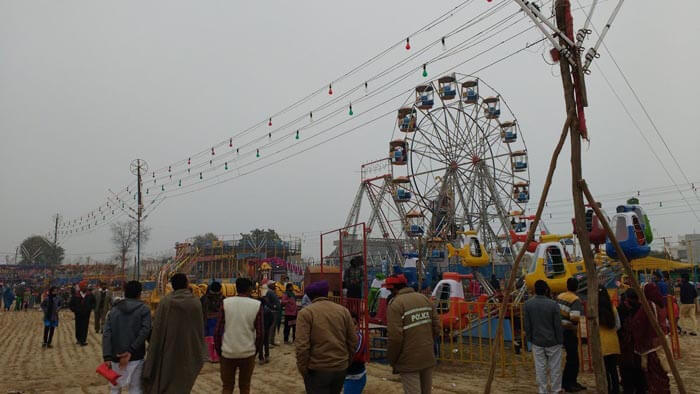Maghi Festival In Punjab

Maghi festival in Punjab is the name for Makar Sankranti festival of India. It is also known as Magha Ra Saza in Himachal Pradesh. It is the first day of the month of Magha in the Bikrami calendar. The festival has many names, like it is called Maghi by north Indian Hindus and Sikhs, and is preceded by Lohri. Lohri marks the harvest of the Rabi crops and the end of the winter solstice. Maghi is also important as it commemorates a major event in Sikh history.
The eve of Maghi is the common Indian festival of Lohri when bonfires are lit in Hindu homes to greet the birth of sons, or marriage in the families and alms are distributed. Following Lohri is the pageant of Maghi, dedicated to forty Sikh warriors killed during the Battle of Muktsar in 1705. They showed tremendous loyalty to the religion and so, they are adored by the people still now. Sikhs in India and worldwide gather in gurdwaras to recite hymns from the Guru Granth Sahib (the Sikh holy book) and watch elaborate recitals.
Taking an early morning dip in the river is considered an essential part of the Maghi celebrations. The largest celebration takes place over three days in Muktsar. Believers bathe in the Sarovar, or sacred pool, and visit shrines associated with the battle. Hindus light sesame oil Diya, as it is known to invite prosperity and drive away all sin.
Maghi in Sikh History
Sikhs remember the death of 40 Sikh warriors who dies trying to stop a Mughal army from capturing Guru Gobind Singh. The battle happened on the first day of the Indian month of Magh, which is given the festival its name. Although Maghi marks a sad event, India’s Sikhs still treat it as a festival. The center of Maghi is the town of Muktsar in Punjab, where the battle took place. Muktsar’s real name was Khidrana. It was named Muktsar or “the pool of liberation,” following the prominent battle of 1705. Their deaths gain greater significance because they had previously abandoned Guru Gobind Singh but later redeemed themselves with bravery.
Guru Gobind Singh Ji personally blessed these Forty Martyrs (or Forty Liberated ones) and cremated them the following day at Muktsar, affirming that they have received Mukti (liberation of soul) for their heroic act. The cremation took place on the first day of the month of Magh (from where the festival derives its name) which now falls on the 13th of January.
Pilgrims travel to observe the festival in the streets and gurudwaras. They bathe in the sacred waters of the town. The festival ends with a procession to the main shrine of Guru Gobind Singh. Though Maghi is not an as big festival as Vaisakhi or Diwali, gurudwaras still perform religious rituals and a reading of the Guru Granth Sahib, just as at many other Sikh festivals.
Muktsar Maghi Mela

Maghi Mela is the annual festival and one of the seasonal gatherings of the Sikhs. Maghi Mela celebrated after the next day of Lohri in January when a fair is organized to commemorate the velour of 40 Muktas. These Muktas sacrificed their lives at the Battle of Khidrana fought between the Mughal army and 10th Guru, Guru Gobind Singh Ji. Pilgrims take bath in the sacred tank on the occasion. The whole town wears a festive look at the time of Mela. At Mukatsar a massive mob accumulates to commemorate the incident.
It is proper fair for all fun-loving families looking forward to spending some quality time together, it is an amazing opportunity to showcase the culture of Punjab with shops selling various items related to Sikhs, children can enjoy camel rides and other fun activities. Even a special stage is set for popular singers who participate in the fair. Merchants display their wares for sale, which include from trinkets to high-end electronics, the weapons Nihangs bear. A big cattle fair is held at village Lambi Dhabi on the occasion of Maghi Mela. The good breed horses, for which Sri Muktsar Sahib is famous throughout Punjab, are showcased at the fair. Punjabi dress, food, music, and dance are all part of the Sikh festival of Maghi.






